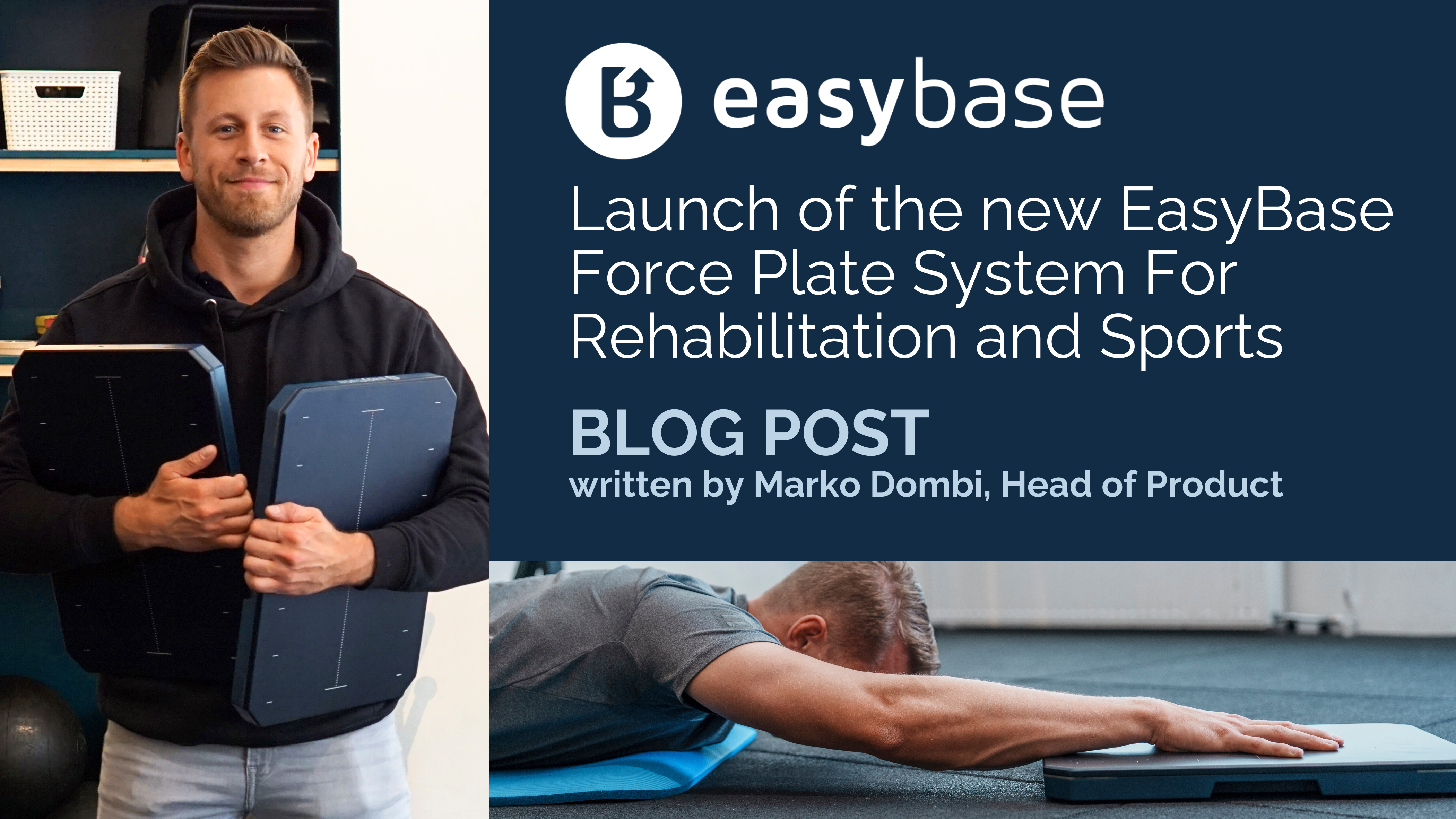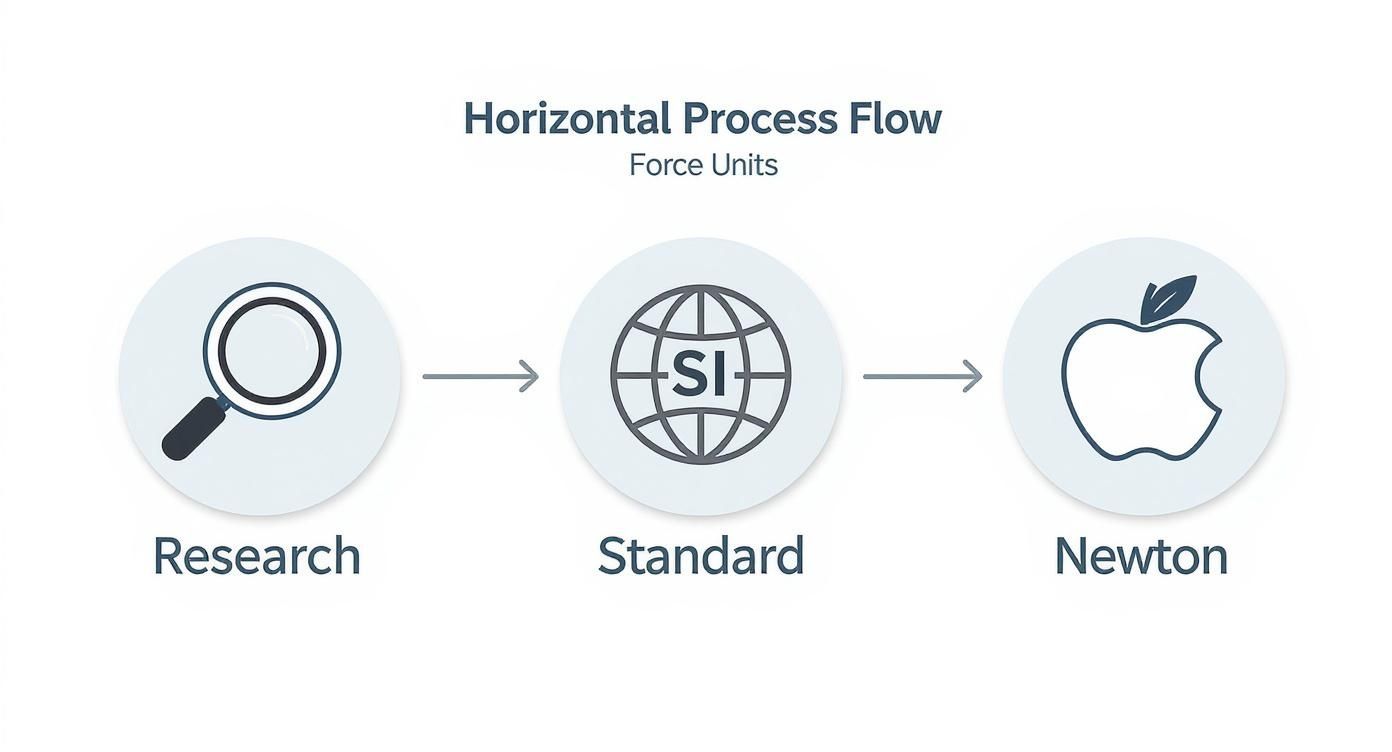-

, by Marko Dombi Athlete-Centric Care: Elevating ACL Rehab with Next-Gen Performance Tools
-

, by Marko Dombi Launch of the EasyBase - Force Plate System For Rehabilitation and Sports
-

, by Marko Dombi Interview with the researcher | Enhanced Paper Grip Test Project
What Is Force Measurement: A Guide for Clinicians and Practitioners
- , by Team Meloq
- 14 min reading time

Discover what is force measurement and why it's essential. This guide explains key methods and applications for physiotherapy and sports performance.
Force measurement is the process of quantifying a push or a pull. In physiotherapy, sports rehabilitation, and performance conditioning, it is the method used to measure the strength a muscle or group of muscles can generate, replacing subjective guesswork with objective, reliable data. This allows practitioners to make informed decisions based on evidence.
Understanding Force Measurement in Modern Practice
At its core, force measurement can be compared to using a highly specialized scale. However, instead of measuring total body weight, it precisely quantifies the output of specific muscle groups. This seemingly simple concept has become fundamental in modern physiotherapy and sports science.

The shift from asking "does that feel strong?" to capturing concrete numbers is significant. It provides clinicians with the objective evidence needed to make critical decisions about patient care, rehabilitation protocols, and return-to-sport criteria with greater confidence.
The Power of Objective Data
Quantifying strength is a cornerstone of evidence-based practice. It allows practitioners to:
- Establish Baselines: Obtain a clear starting point for any rehabilitation or training program, showing exactly where a patient or athlete stands on day one.
- Track Progress: Objective numbers provide clear evidence of improvement over time, which can be a powerful motivator and validate that a treatment plan is effective (1).
- Inform Clinical Decisions: Data-driven insights help pinpoint when an athlete is ready for a safe return to play or when a patient has achieved their recovery goals, minimizing the risk of re-injury.
To better understand these concepts, here is a breakdown of commonly used terms.
Key Concepts in Force Measurement at a Glance
| Concept | Simple Definition | Clinical Relevance |
|---|---|---|
| Force | A push or a pull on an object. | Measures the direct output of a muscle. |
| Dynamometry | The process of measuring force. | The method used to obtain objective strength data. |
| Baseline | An initial measurement for comparison. | The starting point to track progress against. |
| Objectivity | Measurement based on facts, not feelings. | Removes guesswork and personal bias from assessments. |
Having objective data helps practitioners move beyond assumptions and build truly personalized and effective programs for every individual.
According to a systematic review on the topic, objective measures of muscle strength, such as those obtained through hand-held dynamometry, are integral to evidence-based practice and are recommended for use in the examination of patients to help determine the diagnosis, prognosis, and plan of care (2).
This data-first approach is becoming a standard of care. It helps ensure that interventions are not only effective but also safe and appropriately timed for the best possible outcomes.
References
- Deyle GD, Henderson NE, Matekel RL, Ryder MG, Garber MB, Fling SC. Effectiveness of manual physical therapy and exercise in osteoarthritis of the knee: a randomized, controlled trial. Ann Intern Med. 2000 Feb 1;132(3):173-81.
- Stark T, Walker B, Phillips JK, Fejer R, Beck R. Hand-held dynamometry correlation with the gold standard isokinetic dynamometry: a systematic review. PM R. 2011 May;3(5):472-9.
The Scientific Journey to Quantifying Force
To appreciate the precision of today's digital tools, it is helpful to look back at the centuries of scientific inquiry they are built upon. The quest to answer "what is force measurement?" began not in a modern clinic, but with the foundational work of scientific pioneers.
These early thinkers laid the groundwork for the principles we apply today. Isaac Newton, in the 17th century, provided the mathematical language to define force, motion, and gravity. His laws transformed force from a vague concept into something that could be calculated and understood. For a closer look at these core ideas, you can review common force calculation formulas.
From Celestial Bodies to Human Bodies
The drive for precision was not just theoretical; it stemmed from a fundamental need to measure the world. The investigation into force, particularly gravity, has a rich history. Building on the ideas of thinkers like Galileo, Henry Cavendish conducted a pivotal experiment in the late 1700s. He successfully measured the gravitational force between masses in a laboratory setting, a significant step toward quantifying the invisible forces that shape our universe. The European Space Agency offers a timeline of these great physics experiments for those interested in the history.
This relentless pursuit of accuracy in physics directly paved the way for modern biomechanics and physiotherapy.
The same fundamental principles once used to measure the gravitational pull of planets are now harnessed in handheld devices to measure the force produced by a patient's quadriceps.
Viewed this way, the digital dynamometers and force plates in clinics today are more than just tools. They are the direct descendants of a long and brilliant scientific legacy, turning centuries of abstract principles into practical, actionable data that helps improve human health and performance.
How We Speak the Same Language of Strength
Imagine trying to map a patient's recovery if every clinician used a different unit for strength. One physiotherapist might measure in pounds, a specialist might use kilograms, and a performance coach could use a custom scale. This would create confusion and inconsistency.
Such a breakdown in communication would make it nearly impossible to apply research findings consistently, track a patient's progress across different facilities, or ensure safe, evidence-based care. Practitioners would operate in isolation, guessing at the true meaning of the measurements.
To facilitate clear communication and collaboration, the scientific and medical communities needed a universal standard. This ensures that when a sports physiotherapist in Australia reads a research paper from Germany, the data is immediately understandable and applicable. It is the foundation of global collaboration and reliable clinical work.
The Universal Standard for Force
That foundation is the International System of Units (SI), which provides a single, coherent set of measurement standards used in science worldwide. The journey to this system began in 1901 with the MKS (meter-kilogram-second) system, which eventually evolved into the formal SI system adopted in 1960. You can explore the history of this standardized system to understand its development.
For measuring force, the key SI unit is the Newton (N), named after Sir Isaac Newton. This unit is the standard in both clinical and performance settings.
What does one Newton of force feel like? A simple way to visualize it is to imagine holding a small apple in the palm of your hand. The downward pull you feel from gravity is approximately one Newton.
When a device measures a patient's quadriceps strength at 100 Newtons, it means their muscle produced a force equivalent to holding 100 small apples. This tangible unit allows clinicians everywhere to speak the same language of strength, making patient care safer, more consistent, and more effective.
The Technology Behind Modern Force Measurement
How does a handheld device translate a simple push into a precise number on a screen? The work happens inside the device, powered by sensitive technology that converts physical effort into objective data.
At the heart of most digital dynamometers and force plates are components called load cells. A load cell is a transducer designed to turn force into a measurable electrical signal. Inside these load cells are one or more strain gauges. A strain gauge is a tiny, flexible sensor whose electrical resistance changes when it is stretched or compressed.
When a patient pushes against a device, the force physically deforms the strain gauge. This alters its electrical signal—a minuscule change that the device's internal electronics detect, amplify, and convert into a specific value, usually in Newtons. This is the fundamental process that allows us to quantify strength objectively. You can get a deeper look at how a dynamometer is used in physical therapy in our detailed guide.
This infographic breaks down the journey from foundational scientific research to the standardized units we rely on today.

This process illustrates how rigorous scientific investigation leads to universal standards like the Newton, ensuring that a measurement is not only accurate but also universally understood. For demanding applications, validating these technologies requires dedicated facilities like advanced materials testing laboratories.
From Industry to Clinic
This focus on precision is not new; it has roots in the industrial boom of the early 20th century. Between 1899 and 1919, electricity usage in American manufacturing increased dramatically, creating a massive demand for accurate force and electrical measurement standards.
That same drive for precision in industry eventually influenced the development of the tools we now use in clinics and labs to measure human performance.
Applying Force Measurement in Clinical Rehabilitation
This is where the principles of force measurement are applied in practice, transforming how clinicians approach patient care. Objective data provides a powerful lens through which to view recovery, helping practitioners move beyond subjective feedback to build interventions that are truly personalized and effective.

Consider a patient recovering from ACL surgery. In the past, assessment might have relied on manual resistance tests, which can vary between therapists and even between sessions. Today, a clinician can use a digital dynamometer to get a precise strength baseline for the quadriceps and hamstrings. That number becomes an anchor for the entire rehabilitation journey.
From Baselines to Breakthroughs
Once a clear baseline is established, the power of force measurement becomes evident in tracking progress. Regular tests can reveal objective improvements, clearly showing how a patient’s force output is increasing over time. This data is validating, confirming that the treatment plan is working and giving both the clinician and the patient confidence in the recovery process.
For example, observing a 15% increase in quadriceps strength over two weeks is a solid, concrete metric. It can motivate the patient and justify continuing the current exercise protocol. It also helps in spotting plateaus early, signaling that it might be time to adjust the plan. This concept is not limited to human rehabilitation; the principles of physical assessment are also vital in fields like pet physical therapy, where objective force data can significantly improve accuracy.
Using objective data to guide rehabilitation is a key component of best practice. It empowers clinicians to make data-driven decisions at every stage of care, from initial assessment to final discharge.
Making Data-Driven Decisions
This data-driven approach is invaluable for complex decisions like clearing an athlete for return to sport. By comparing the force output of the injured limb to the uninjured one, clinicians can calculate the limb symmetry index (LSI). An LSI of 90% or greater is a widely accepted benchmark that may help in reducing the risk of reinjury (1). Functional tests also play a crucial role. You can review the data behind such assessments by looking at sit-to-stand test norms and their clinical relevance.
Ultimately, objective force measurement empowers you to:
- Identify imbalances that could lead to compensatory movements or further injury.
- Communicate progress to patients with clear, motivating numbers.
- Personalize treatment plans based on each individual's unique strength profile.
This shift from "it feels stronger" to "it is stronger, and here's the proof" is fundamental to modern, evidence-based rehabilitation.
References
- Grindem H, Snyder-Mackler L, Moksnes H, Engebretsen L, Risberg MA. Simple decision rules can reduce reinjury risk by 84% after ACL reconstruction: the Delaware-Oslo ACL cohort study. Br J Sports Med. 2016 Jul;50(13):804-8.
Using Force Data to Unlock Athletic Potential
Beyond rehabilitation, force measurement is a significant advantage for enhancing human performance and giving athletes a competitive edge. Sports scientists and conditioning coaches increasingly rely on objective data to move beyond guesswork and build highly specific training programs.
The focus has shifted from simply counting repetitions and sets to measuring specific outputs directly tied to athletic ability. This provides a clear picture of how an athlete's strength in the gym translates to performance on the field, court, or track.
Key Performance Indicators in Sports
In performance training, two metrics are particularly important: Maximal Voluntary Isometric Contraction (MVIC) and Rate of Force Development (RFD).
- MVIC is a measure of an athlete's absolute peak strength. It indicates the maximum force a muscle group can generate in a single, static effort.
- RFD measures explosiveness—how quickly an athlete can generate force. This is critical for actions like sprinting, jumping, or throwing.
Tracking these numbers provides coaches with a detailed roadmap of an athlete’s physical profile. For example, a weightlifter may have a high MVIC, while a sprinter requires an exceptional RFD to explode from the starting blocks. Tools like force plates are invaluable for capturing this comprehensive picture. You can learn more about force plate testing and its applications in our detailed guide.
Monitoring force data throughout a season can also be a powerful tool for managing fatigue and preventing overtraining. A sudden dip in an athlete’s force output can be an early warning sign, allowing coaches to adjust training loads and prioritize recovery before an injury occurs.
Ultimately, objective force measurement helps ensure that time spent in training leads to real, measurable improvements in sport-specific performance.
Common Questions About Force Measurement
When clinicians and coaches begin exploring force measurement, several key questions often arise. Let's address some of the most common ones.
What's the Difference Between Force and Pressure?
It is easy to confuse these two terms, but the distinction is important. Force is the total push or pull on an object, measured in Newtons (N). Pressure, on the other hand, is that force distributed over a specific area, measured in Pascals (Pa).
In a clinical or training setting, the primary interest is almost always the total force a muscle group can generate. The goal is to measure absolute strength, not how that strength is distributed over the surface of the testing device.
Why Is Isometric Testing So Common?
Isometric testing is widely used in strength assessment for good reason. By having a muscle contract without changing its length, we can obtain a reliable and repeatable measure of peak force production (1).
It is a clean, stable, and safe method for establishing a strength baseline and tracking progress over time. Essentially, it removes the complex variables of movement, speed, and momentum from the equation to isolate and measure pure strength.
Can This Data Really Help Predict Injury Risk?
While no single metric can predict the future, force measurement is a valuable component of injury prevention strategies. Research indicates that significant strength imbalances between limbs or between opposing muscle groups are associated with an increased risk for certain injuries, particularly in athletes (2).
Identifying these asymmetries early provides an opportunity to intervene with targeted training before they contribute to a more serious issue on the field or in the gym.
Ready to stop guessing and start measuring? The Meloq ecosystem offers portable, highly accurate tools like the EasyForce dynamometer and the EasyBase force plate. These tools provide everything needed to quantify strength, monitor progress, and make confident, data-driven decisions for your clients and athletes.
Discover the tools trusted by leading clinicians at https://www.meloqdevices.com.
References
- Bohannon RW. Test-retest reliability of hand-held dynamometry during a single session of strength assessment. Phys Ther. 1986 Feb;66(2):206-9.
- Croisier JL, Ganteaume S, Binet J, Genty M, Ferret JM. Strength imbalances and prevention of hamstring injury in professional soccer players: a prospective study. Am J Sports Med. 2008 Aug;36(8):1469-75.



